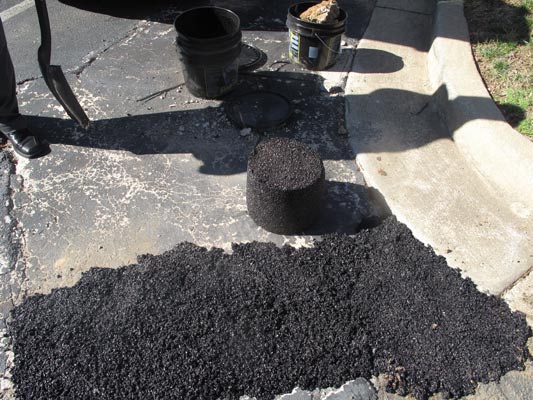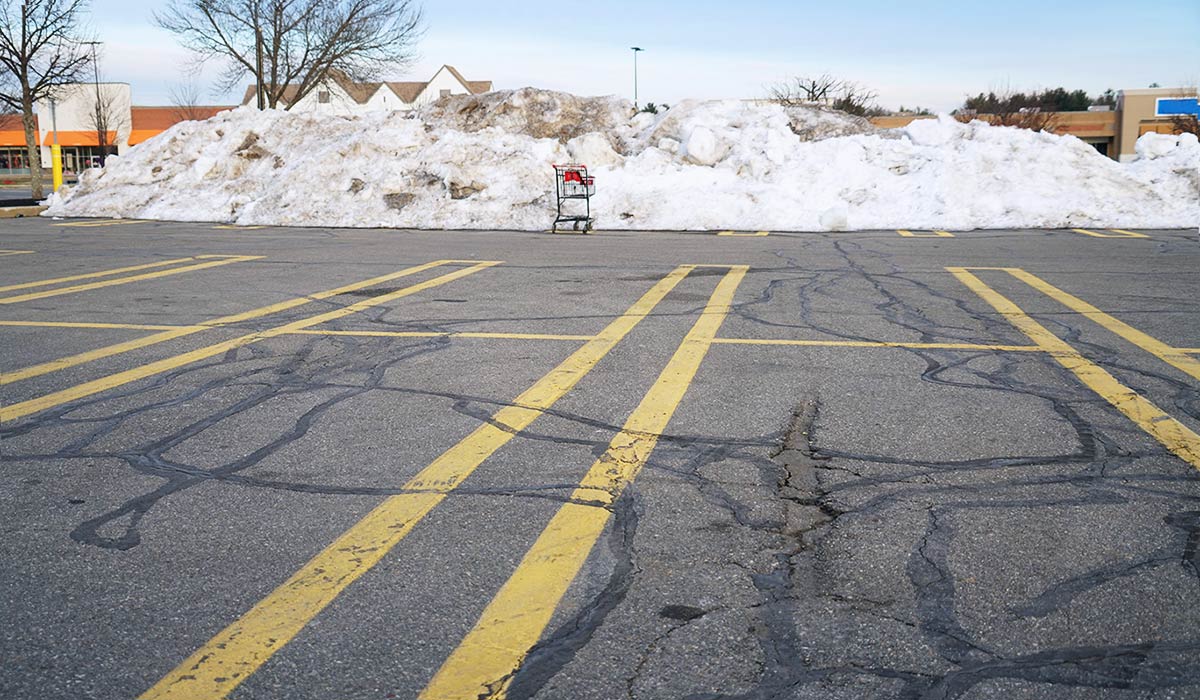How to Fix a Pothole
There are two ways you can fill a pothole, and lucky for you, both are easy to do. Take a look at your options below.
Pothole Fixing Option #1: Cold Pothole Patch
Cold pothole patching involves using a "cold patch" asphalt material that often comes out of a bag or pail. This is an easy DIY solution for homeowners and property owners, but it can be unattractive. Aggregates in the cold patch can easily be displaced and hit the bottoms of vehicles that go over the patch.
 Photo: Applying cold patch into a large pothole
Photo: Applying cold patch into a large pothole
Supplies and Tools You Will Need
- Asphalt Pothole Patch
- A wire street broom
- A shovel or an asphalt lute or rake
- A tamper tool, asphalt roller, or plate compactor
Step 1: Clean. How to fix a pothole requires cleaning. First, remove all pebbles and loose pieces of asphalt from the pothole. Use your wire street broom to thoroughly clean the pothole and surrounding area.
Step 2: Pour. Pour cold mix asphalt patch into the hole. Make sure to pour enough pothole mix to prevent a depression from forming when you tamp it down.
Step 3: Rake. Get your shovel, lute, or rake and spread the asphalt patch inside the pothole. If the product is water-activated like Aquaphalt 6.0 Asphalt Patch, get a watering can, water bottle or garden hose, and gently pour a bit of water into the patch.
Step 4: Compact. Get your tamper tool, asphalt roller, or plate compactor and tamp it down. Once the surface is relatively even, you can drive on it as soon as you wish. You can also drive across the newly patched pothole to compact it.
Pothole Fixing Option #2: Infrared Patching
Infrared patching is an excellent option for pothole repairs. This process involves heating up the asphalt, adding a rejuvenator to restore the binders, and reworking the asphalt. The result? A sturdy patch!
Video: How to fix potholes with an infrared patching machine
Supplies, Tools, and Equipment You Will Need
- A wire street broom
- Mini Infrared Asphalt Heater
- An asphalt lute and rake
- A shovel
- Some asphalt millings (transport in an asphalt hot box)
- Some asphalt millings rejuvenator
- A tamper tool, asphalt roller, or plate compactor
Step 1: Clean. Use your wire street broom to remove rocks and loose asphalt from the pothole. Pull weeds by hand and use a leaf blower to keep the surrounding area clean.
Step 2: Heat. Wheel the Mini Infrared Asphalt Heater above the depression and turn it on. Wait for 5 to 7 minutes before removing the machine to ensure that the section is completely soft and reworkable.
Step 3. Rake. Get your asphalt lute and start fixing the pothole by reworking it, starting at the edges. Use the blunt side of the lute to push the edges of the square a couple of inches to the center. Once done, flip the lute so that the sharp edge faces the pothole and start reworking the entire area. Add some hot asphalt millings before spritzing some asphalt millings rejuvenator into the asphalt. Rake again to ensure that the surface is level.
Step 4: Compact. Use a tamper tool, asphalt roller or plate compactor to compact the newly repaired section.
How to Prevent Potholes from Forming
You’ve learned how potholes form. Now, follow these tips to keep your asphalt parking lot or driveway pothole-free.
1. Set aside a day each week to clean your driveway or parking lot
You don't need a pressure washer to clean an asphalt driveway or parking lot. All you need is a wire street broom to remove dust, leaves, and pebbles. Don't have a wire street broom? A sturdy poly street broom will do, too.
Regular cleaning doesn't just make the asphalt look clean and attractive. This is also the best time to check for oil stains, as well as weed and moss growth. This is also your chance to assess any damage present in the asphalt and see if there are problematic areas that need to be addressed immediately.
2. Fill or patch cracks right away
Those small cracks or alligator cracking might not look like a threat right now. But neglect them, and they will eventually turn into large cracks and ugly potholes.
Luckily, filling or patching cracks is easy, and anyone can do it. For small asphalt cracks, you can use a liquid cold pour crack filler or have an asphalt contractor fix them with a hot pour rubberized crack filler.
Prevent alligator cracks from forming and deteriorating into potholes by patching them immediately. We recommend a product called Gator Patch to fill those tiny cracks and prevent rainwater and snowmelt from seeping into the foundation.
Here's a handy guide on how to use Gator Patch to fix alligator cracking.
Video: How to fix alligator cracks with Gator Patch
3. Seal your asphalt every 2 to 3 years
Many things can leave you needing to fix potholes. Chief among them is frequent exposure to the sun, rainwater, snowmelt and chemicals.
Protect your asphalt and keep it pothole-free for many years by having it sealed every two to three years.
Asphalt sealer serves as the pavement's shield against frequent exposure to moisture, chemicals and the sun's UV rays. This substance not only protects your asphalt but also restores its beautiful black color.
4. Get rid of weeds
Did you spot weeds growing between cracks? Get rid of weeds with a little elbow grease by hand-pulling them. You can also kill off smaller weeds by using a heat lance. Check out these other options to get rid of weeds.
5. Clean up oil stains ASAP
Frequent exposure to the elements is not the only thing that could damage asphalt pavements. Spilled oil and fuel can also eat away at the asphalt and weaken it.
So, get rid of oil stains as soon as you spot them. You can use cat litter, baking soda, or green degreaser to remove oil and fuel stains.
6. Improve Your Parking Lot or Driveway’s Drainage
Standing water can chip away at the sealcoating and seep through small cracks in the asphalt to weaken the foundation of the pavement, leaving you needing to fix potholes. Remove puddles immediately and improve drainage to prevent potholes from forming.
Conclusion:
Now that you know how to fix a pothole in four easy steps, you can start fixing it before it damages your car or causes any injuries.
Ready to order an asphalt patch or your first Infrared Asphalt Heater? Then, check out the Asphalt Kingdom’s Asphalt Patch Repair store or the Asphalt Infrared Patching store to order your supplies and equipment.











-2.jpg)